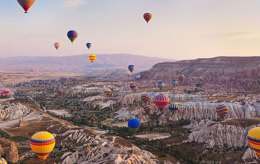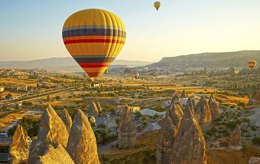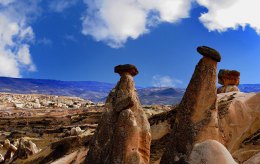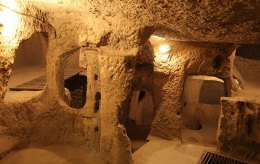CONGRESS INFORMATION
The Cappadocia region is the place where nature and history beautifully come together. In strange rock formations, shaped during the historical period, humans carried the signs of a civilization, with carving houses and churches and decorated them with frescoes. Because of the Byzantine artwork inside the churches, Goreme National Park is a UNESCO World Heritage Site.
Zelve Valley which is spread out over three valleys, two of which are connected by a tunnel, has the most intensive chimney rocks formed in the volcanic tufa. The chimney rocks of the valley are with sharpen ends and large trunks. There are many settlements in the volcanic tufa used by the first Christians hiding from the Roman soldiers. In these settlements there are many abbeys and churches. The church named Direkli Church is dated from the the first years of abbey life of Zelve. The relief crosses in the trimmings of the churches are mostly iconoclastic. The most important churches of the valley are Balikli, Uzumlu and Geyikli. These churches date to the pre-iconoclastic period. The valley also contains accommodation places, mills, mosques and dovecotes.
Uchisar Castle The hill of the castle of Uchisar is a panoramic watching point. The numerous rooms, steps, tunnels and galleries inside the castle are connected to each other. At the entrance of the rooms there are sliding stones used to control the access. On the chimney rock and around the castle, many dovecotes has been constructed. The doves were used as a mean to communicate with the other settlement regions. A legend says that dwarfs were living at Uchisar because of the very narrow passages in the castle. There are three tombs on the top of the castle.
Kaymaklı Underground City is one of the most interesting underground settlements in Cappadocia and the place where many early Christians hid from persecutors.
Certainly the most interesting features of the Cappadocia area are the underground cities founded within. Although about 40 underground cities have been determined (discovered, found) until now only six of them are open for visit Nobody can know the number of underground cities in the Cappadocia area. Well known underground cities are Tatlarin Underground city Derinkuyu Underground City, Ozkonak Underground City, Mazi Village Underground City, Kaymakli Underground City and Gaziemir Underground City.
Avanos is the center of terra cotta art since 3000 BC. Even today, the best Turkish pottery is still created there. In antiquity Avanos is referred to as Vanessa. The most important feature of the region is the manufacture of clay jugs, biscuits, and jars. The jar makers are continuing their traditions from the period of the Hittites until nowadays.
Ruins belonging to different cultures, from the Old Bronze Age until the Late Roman Period, have been discovered during the archeological diggings in the Zank Mound near the town Sarilar of Avanos.
The Goreme Open Air Museum has a large collection of early Christian churches decorated with unique frescoes. The valley is famous for the chimney rocks formed as a result of the natural erosion and for its historical richness. The intensive emigration of the first Christians escaping from the pressure of the Roman soldiers created an important religious place with many abbeys, churches and houses in the volcanic rocks of the valley where they could easily hide. Nowadays more than 250 churches, such as Elmali Church, Saint Barbara Church, Carikli Church, Tokali Church and Hidden Church are found in Goreme. In these churches there are scenes from the life of Jesus, descriptions of the saints who wrote the Bible and pictures of Saint Barbara and Saint Georges.
One of the most popular and enjoyable aspects of Cappadocia are the spectacular balloon flights undertaken in the area. The balloon cruises start early in the morning and offer awesome views of the landscape populated with fairy chimneys. You will experience unforgettable moments observing the ever-changing colors of the sunrise illuminating the historical beauties of the region.
Travelling at heights of up to 1.500 feet the earth slowly descends and rotates below you. It is like a dream to gently float over the countryside in complete harmony with your surroundings.
10 Interesting Facts About Cappadocia
1. Cappadocia's attraction to tourists is mainly because of the lunar-like mushroom shaped fairies. They were formed by erosion of volcanic sediments that later solidified into a soft rock known as tuff. In due time, the winds will then erode the rocks' surface leaving the smooth core of the rocks.
2. The soft tuff rocks were easily carved and presented a chance for the early inhabitants of Cappadocia to carve underground and over-ground shelters.
3. Cappadocia cuts across 3 central Anatolia provinces including; Nevşehir, Keyseri, and Niğde. It covers an area of about 5,000 square kilometers.
4. The name 'Cappadocia' is derived from the Persian word 'Katpaktukya' which is translated as 'the land of beautiful horses'.
5. Not all parts of Cappadocia get tourists. If you are lucky enough to visit a town such as Gulşehir, you will receive more than your fair share of attention in a bid to market it as tourist friendly too.
6. Cappadocia was formed about three to four million years when a series of volcanic eruptions shook the Central Anatolia plateau. The results were the Cappadocia fairies.
7. During the Arab invasion, the retreating Christians used to hide in the underground cities in Gerome. The name Gerome is translated to mea 'you cannot see in here'.
8. Cappadocia of the Ancient was largely a monastery. The lifestyle was established by Basil of Caesarea who encouraged Christian monks to gather in the monasteries and pray together.
9. In Byzantine Cappadocia, Tokali Kilise church was the main prayer site. It boasts some of the best preserved paintings from the Middle Ages.
10. The Mount Aktepe near Göreme and the Rock Sites of Cappadocia are listed by UNESCO as World Heritage Sites.
Cappadocia is best seen from a hot air balloon. The ride makes you feel like you are in a space ship and are capturing the views of the moon surface.








